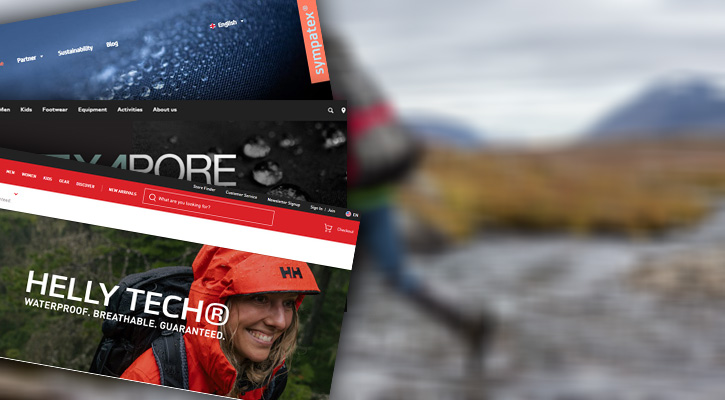
Are you looking for a waterproof and breathable fabric that can stand up to the elements, but want to explore options beyond the well-known GORE-TEX?
Whether you’re an outdoor enthusiast or just someone who wants to stay dry in the rain, there are several alternatives to GORE-TEX® that offer comparable protection and comfort. And sometimes lower prices!
In this article, we’ll dive into 7 innovative materials that are popular in the world of waterproof and breathable membranes.
From eco-friendly options to budget-friendly choices, these are designed to keep you dry without compromising on breathability.
So, let’s take a look!
GORE-TEX® Alternatives:
1. Helly Tech®
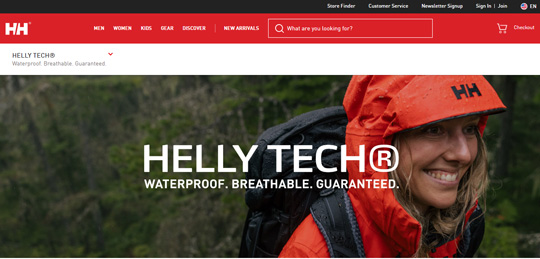
Helly Hansen official website: Helly Tech®
Developed by the Norwegian company Helly Hansen, which was founded in 1877 by a pioneering couple just like the creators of Gore-Tex, the Helly Tech® innovation represents a significant advancement in the realm of outdoor apparel.
Launched into the marketplace in 1980, Helly Tech is a staple in the production of outdoor clothing that demands both breathability and resistance to water.
Distinctive in its approach, this technology leverages the hydrophilic characteristics of the fabric, as opposed to relying on hydrophobic qualities.
The fabric’s structure is both microporous and hydrophilic, which means that while it allows the passage of moisture from the body in vapor form, it simultaneously blocks the entry of water droplets.
The construction of Helly Tech garments includes a tri-layer system: the external layer is treated with a Durable Water Repellent (DWR) finish to fend off water and chill breezes, followed by a waterproof yet breathable middle layer, and then an innermost layer composed of a mesh material or another permeable fabric.
Helly Tech is available in three distinct performance grades: Protection, Performance, and Professional, each tailored to varying degrees of outdoor pursuits and environmental conditions.
Learn more: Helly Tech® vs Gore-Tex: Which is Better?
2. Texapore
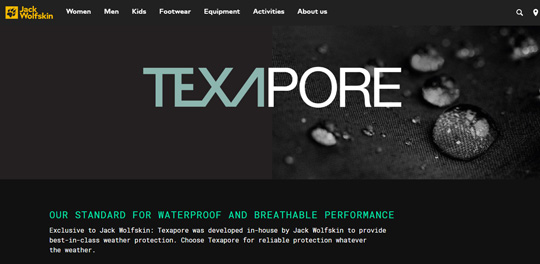
Jack Wolfskin official website: Texapore
Crafted by Jack Wolfskin, a German label that is often featured on our website, Texapore is a fabric innovation synonymous with the brand. Renowned within Germany and increasingly recognized abroad, Jack Wolfskin has been expanding its international presence.
The brand engineered Texapore to create high-performance apparel capable of offering superior protection from the elements while maintaining breathability.
As a material technology, Texapore is constructed to shield against wind and rain, while allowing for air circulation, and is available in different levels of performance to suit various needs. Additionally, it is treated with a Durable Water Repellent (DWR) finish, enhancing its ability to shed water and prevent saturation.
Texapore is available in these performance options:
- Texapore Core (Basic protection)
- Texapore Pro (Active comfort)
- Texapore Ecosphere Core (Conscious weather protection)
- Texapore Ecosphere Pro (Sustainable premium protection)
Read also: Gore-Tex® vs Texapore Fabric Technology: Which is Better?
3. Sympatex
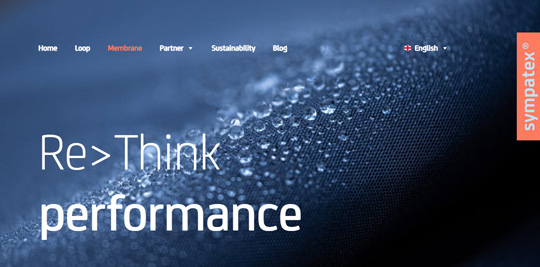
Sympatex official website
Developed by SympaTex Technologies GmbH, a German company, the waterproof fabric technology called Sympatex offers a distinctive advantage over its counterparts – it is environmentally friendly and entirely recyclable. This is attributed to its composition of a hydrophilic polyether-ester polymer, a natural biodegradable material.
Sympatex has garnered several certifications, such as the Oeko-Tex Standard, ensuring its safety for human use, and the Bluesign certification, attesting to its eco-friendly nature.
In contrast to Gore-Tex’s ePTFE, Sympatex features a non-porous membrane. Nonetheless, it maintains breathability through a chemical process facilitated by the hydrophilic properties of its components.
The membrane’s capacity to absorb significant moisture enables it to expand, facilitating the movement of moisture from the body through the molecular chains. Also, the warmer and more humid the interior of the garment, the greater the membrane’s capability to transport moisture outward.
Sympatex can be combined with various materials to form a laminate suitable for a range of apparel, including footwear.
Sympatex laminate options:
- 2L Laminate
- 2.5L Laminate
- 3L Laminate
- 4L Laminate
Don’t miss: Sympatex vs Gore-Tex®: Which is Better?
4. Dermizax™
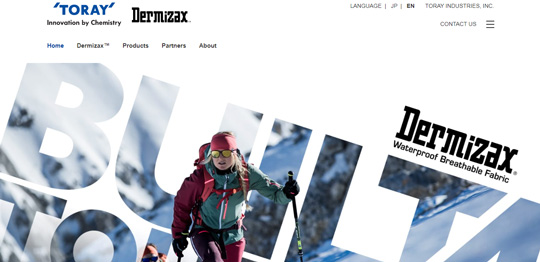
Toray Dermizax’s official website
In 1995, Toray Industries, a Japanese chemical company tracing its origins back to the 1920s, unveiled the pioneering Dermizax membrane.
Composed of polyurethane (PU), Dermizax functions as a waterproof and breathable membrane, distinguishing itself from Gore-Tex by its non-microporous nature, although certain versions do incorporate micropores.
Dermizax relies on the hydrophilic properties of its molecules to facilitate the movement of sweat vapor from the interior to the membrane’s surface, where it exits the garment, ensuring exceptional breathability. The swiftness of water vapor transport to the surface represents a crucial determinant.
In essence, hydrophilic materials attract water, while hydrophobic materials repel it. The original Dermizax membrane had no pores and had hydrophilic characteristics.
Over time, Toray has developed other versions of Dermizax tailored for various outdoor pursuits, integrating both hydrophilic and hydrophobic materials and integrating microporous membranes.
Dermizax attains peak breathability when the wearer perspires heavily during vigorous activity in cold, dry conditions. Conversely, the breathability of hydrophilic membranes typically diminishes in hot and humid environments. Comparable to Gore-Tex, Dermizax apparel incorporates Durable Water Repellent (DWR) coatings.
Primarily utilized in snow sports such as skiing and snowboarding, as well as mountain activities gear, Dermizax is lauded by many for its elastic and comfortable texture.
Dermizax Options:
- Dermizax: the original fabric for a range of sports.
- Dermizax EV: for intense activities with higher breathability.
- Dermizax NX: with even greater breathability, for intense sports in extreme weather.
Learn more: Gore-Tex® vs Dermizax: Which is Better?
5. DryVent™
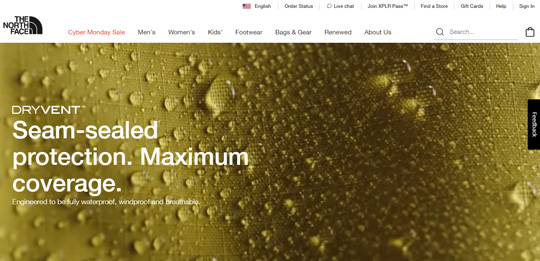
DryVent: The North Face official website
The DryVent™ fabric has been developed by The North Face and it represents one of the brand’s best fabric technologies.
This American outdoor apparel company places significant emphasis on the performance of its gear. The material employed in DryVent™ is polyurethane (PU). Similar to Gore-Tex®, DryVent™ boasts the following qualities:
Waterproofness: Functioning as a membrane, DryVent™ delivers comprehensive waterproofing and is additionally treated with a Durable Water Repellent (DWR) finish to not only repel water but also prompt it to bead off the jacket, reducing contact time.
Windproofness: Engineered with multiple layers, DryVent™ effectively shields against winds.
Breathability: DryVent™ also demonstrates exceptional breathability, facilitating the escape of perspiration from the body through moisture vapor, thus preventing overheating and excessive moisture buildup inside the jacket.
DryVent™ Options:
- DryVent 2L: 2-layer construction, a versatile choice for everyday wear.
- DryVent 2.5L: for dynamic activities, with a lightweight and packable design.
- DryVent 3L: for technical, high-performance clothing and gear for challenging conditions.
Read also: Gore-Tex® vs DryVent™: Which is Better?
6. Powertex
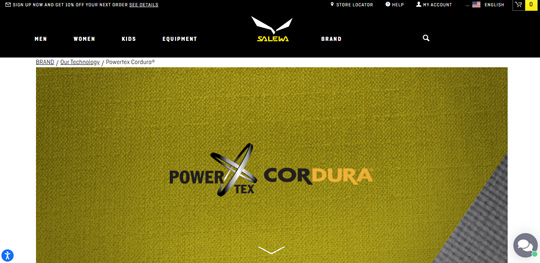
SALEWA Powertex Cordura: salewa.com
SALEWA has developed its proprietary Powertex fabric to deliver exceptional durability, rendering it ideally suited for the demanding requirements of off-piste skiing and alpine ski touring.
This three-layered laminate material offers protection against bad weather, with remarkable robustness, waterproof properties, and superior breathability.
Featuring an ultra-thin polyurethane (PU) membrane that actively expels moisture vapor to the exterior, while the incorporation of CORDURA® nylon bolsters the fabric’s resistance to abrasion. It’s also complemented by 6% stretchable elastane to enhance movement and flexibility.
The environmentally conscious, PFC-free water-repellent finish aids in water resistance, increasing the membrane’s performance.
This is the Powertex 3L version. A Powertex 2L version is also available, comprising two layers and offering different features and lower performance.
Powertex is ideal for activities such as skiing, snowboarding, hiking, and mountain climbing.
Learn more: Powertex vs Gore-Tex: A Comparison
7. Omni-Tech™
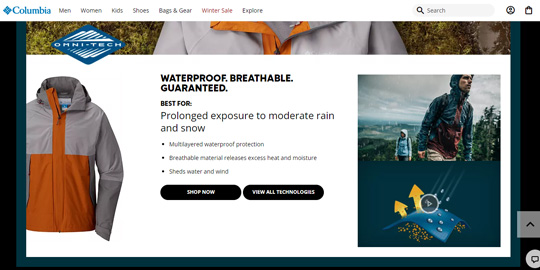
Omni-Tech: Columbia’s official website
Columbia Sportswear, a well-known American brand frequently highlighted in our comparisons and selections, has developed Omni-Tech, a technology that surpasses basic waterproofing by also offering stain resistance and breathability.
The importance of breathability in waterproof jackets is often underestimated but is highly valued by skiers, hikers, and runners for its impact on comfort and performance.
Omni-Tech consists of multiple layers, with the outer layer treated with Omni-Shield™ for stain and water repellency. The water-repelling feature is crucial for preventing water buildup and improving protection against rain and snow.
The waterproof membrane in the second layer significantly enhances Omni-Tech’s water resistance, while the third layer aids in moisture-wicking through body heat.
Omni-Tech provides a soft, comfortable feel without the usual stiffness associated with waterproof fabrics.
